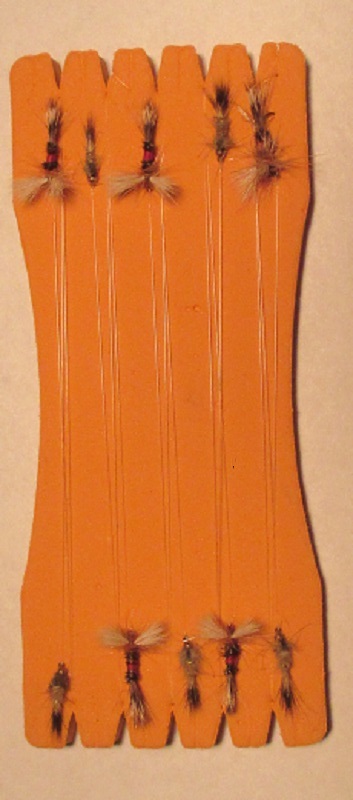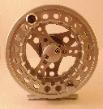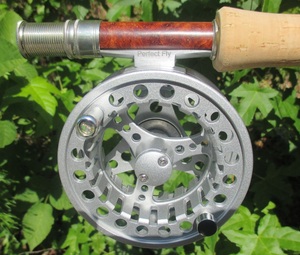
We receive several telephone calls or email messages a day requesting information on the various streams we cover and have web pages on. When the weather first starts turning cold, the number one question we get other than what flies to use, is when to use dry flies and when to use nymphs. Some anglers writing or calling us know the water temperature of the stream they plan on fishing but most do not. Of course, that is a big help but making that decision solely based on water temperature could be a big mistake. There are times when you may want to fish a nymph when the water temperature is 55 degrees F. and higher. There isn’t a magic temperature range for fishing a nymph or a dry fly. The same thing applies to streamers.
Many anglers simply ask “when does the water get too cold to catch trout on the dry fly”. With several exceptions I want go into, the general answer is around 45 degrees. Angie and I have caught many trout on dry adult stoneflies, mayflies and caddisfly patterns at a slightly lower temperature of around 42 to 44 degrees. This was after the particular species of insect began hatching following a day or two of 50 degrees or higher water temperatures. If there is a lot of food on the surface of the water, the trout will usually eat it, even when the water temperature is as low as the mid forties. Trout will usually eat emerging nymphs or pupae much more readily, but in some cases they will continue to hit the adult dry flies. The above advice is fine for those that only want to fish a dry fly. The problem with it is that even though you may catch some trout on the dry fly in the colder water, the odds of success may be very low as compared to fishing nymphs, emergers, larva, pupae or streamers.
The next email was pertaining to where to find the fish. More specifically on the bottom, mid range or surface. There is no answer to this question. The trout may be in either of those water levels depending on many factors. The water temperature is not one of them. When trout are inactive they tend to stay on or near the bottom. This also gives them some protection from overhead predators. You may also find them in very shallow water and of course suspended in between the bottom and surface. The water temperature is not the factor. Remember, the fish are perfectly comfortable anywhere in the stream as far as the temperature is concerned. The main thing to look for is slow to still water. They want hold for long in fast water because they will expend more energy than they can take in. Now the
problem with this is that you may be looking at a fast run, for example, with the surface water moving very fast, when down near the bottom, between and behind rocks, the water may be moving very slow. In some cases it may move very little. So you cannot go by what you see on the surface. Near the banks, for another example, the water may be swift. However, there is usually some pockets along the bank where it move slow, eddies and can even be practically still. Just keep in mind, moving water can be deceptive. Trout do not need depth from a temperature standpoint. It would be a rare situation for the water to get warmer deeper. Most trout streams are generally not that deep. Even if they were, keep in mind, trout do not move to warmer water for comfort. They will feed more in warmer water but they want move strictly for temperature purposes.
The last question is easy to answer. It was “do you need to fish the sunny areas of the water in the winter”? The answer to that (unless you can find some still water and there is little of that) is no. The sun has the effect of helping to warm the entire stream, even if it shines in only a few places. Since
the water is moving, it makes no difference in the water temperature, even in the area the sun is shinning on. It may help you keep warm and it may even help you think you will do better but that is about it. It doesn’t mean the water is warmer there than it is downstream.
Summary: As ridiculous as it is, sometimes I believe that just the fact that anglers sometimes feel cold when they are fishing during very cold weather, allows their mind to play games on them. Solutions like “Fishing the sunny spots”; “thinking that the trout are cold, and looking for warm water (in the same sense we warm blooded creatures get cold)”; “fishing deep and on the bottom is the answer”; “you can’t catch trout in cold water” and other mistaken beliefs compare well to some of the best ever “Old Wives Tales”.
Dear Fly Angler;
Trout anglers can select from a huge selection of flies to match the hatch with Perfect Flies that look like the real insects and other foods trout feed on. Saltwater, Bass, Pike, Muskie, Salmon and Steelhead anglers can select from the most effective flies available. Perfect Fly- fly rods, reels, leaders, tippet and accessories are the best quality for the price because we have no Sales Reps or Distributors to pay.
Perfect Fly “Fly Selections” (Click Here) Save 20% over individual fly purchases
Over forty (40) Trout Fly Selections for various sections of the United States. We also have hundreds of Custom Trout Fly Selections. Call us at 800-594-4726 or send us an email (sales@perfectflystore.com) with the name of the stream or location you plan on fishing, the period of time that you will be fishing there, and we will put a fly selection together for you for that period of time and location. All fly selections are available with or without a fly box. Steelhead and Salmon Fly Selections Largemouth bass, smallmouth bass, bream, panfish, pike, muskie Fly Selections and Saltwater Fly Selections

Perfect Fly “Pre-rigged Foam Dropper Rigs” (Click Here)
I doubt we have to tell you about the high popularity of dropper rigs. Most fly anglers love them, and some even consider dry dropper rigs to be a necessity when fly fishing for trout. In essence, the dry fly becomes a strike indicator that not only tells you when a trout takes the dropper fly, usually a nymph or emerger, but also catches surface-feeding trout. The biggest advantage of using a dropper rig, especially the double nymph rig, is that it doesn’t require close observation and feel to detect strikes when fishing an emerger, or nymph, without a strike indicator.

Perfect Fly “Pre-rigged Tandem Midge Larva and Pupa tippet”: Our two-fly midge setups are pre-rigged on a plastic spool at Perfect Fly and include about two and a half feet of tippet to attach to your leader. The rigs can be purchased with nylon mono tippet or fluorocarbon tippet. Size 20 flies are rigged on 5X tippet, and size 22 flies on 6X tippet. The pre-rigged tandem midges are available in cream, light green and red (blood midge) colors. They are stored on a plastic spool so that you can easily remove them and tie them onto your leader without any mess of fuss. The tag end of the tippet is marked with a small piece of plastic tape. The foam spools can be reused.
Click Here For Pre-rigged Tandem Midges (Bottom of Page)
“Perfect Fly” Pro Fly Rods and Fly Rod Combination:
Click Here for our (Lowest Price-Best Selling) Fly Rod and Fly Rod Series combinations. All fly rods are available in combination sets with rod, reel, and fly lines.
1.We have a new line of Perfect Fly Euro/nymph rods
2. A new Perfect Fly Power Pack Spey fly rod.
3. Perfect Fly Switch fly rods.
4. Perfect Fly SS series rods.
5. Perfect Fly Journeyman rods
6. Perfect Fly Pro series rods.
7. Perfect Fly Master series rods
8. Better Getting started fly fishing sets -rods, reels, line, leaders, leaders, tippet, accessories and flies.
9. Best Getting started fly fishing sets-same as above.




“Perfect Fly” SR Fly Reels: (Click Here) Wide arbor, smooth reeling and drag, aluminum 3 ball bearing fly reels available with extra spools. Available in 3/4, 5/6, 7/8 and 9/10 sizes.

“Perfect Fly” fly fishing DVD” Nineteen (19) instructional programs.The “Fly Fishing DVD ” video series teaches all aspects of fly-fishing from its very basics to its most advanced levels. It was conceived and designed to bring anglers a greater knowledge of the fish they pursue and the insects and other sources of food they survive on. As the introductions say, “You can get your Ph.D. in fly-fishing right here”..jpg)
Perfect Fly” Gift Cards: You can buy them online here, or call us at 800 594 4726 to order. We e-mail a card number that can be used immediately. Our gift cards never expire. Gift cards can be redeemed for merchandise online or for phone orders.
Free Shipping in the Continental United States